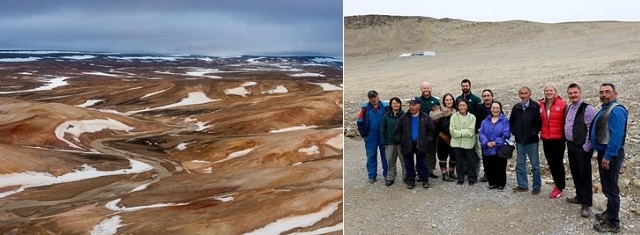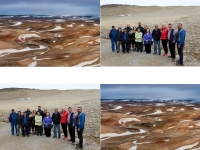Travel
PARKS CANADA & QIKIQYANI INUIT ASSOCIATION Open Qausuittuq National Park
Composed of a Cluster of Islands

(Source: Parks Canada)
USPA NEWS -
Qausuittuq National Park, composed of a Cluster of Islands in the High Arctic has been a significant Historical Site for Inuit dating back 4,500 years. The National Park is a Traditional Hunting and Fishing Area that has sustained Inuit of Resolute Bay in the recent past....
Qausuittuq National Park, composed of a Cluster of Islands in the High Arctic has been a significant Historical Site for Inuit dating back 4,500 years. The National Park is a Traditional Hunting and Fishing Area that has sustained Inuit of Resolute Bay in the recent past. National parks represent the very best that Canada has to offer and tell stories of who we are, including the hHstory, Cultures and Contributions of Inuit Peoples.
On august 10, the Minister of Environment and Climate Change and Minister responsible for Parks Canada, Catherine McKenna, along with P.J. Akeeagok, President of the Qikiqtani Inuit Association (QIA), officially opened Qausuittuq National Park at a ceremony held in the community of Qausuittuq/Resolute Bay.
The Inuit Impact Benefit Agreement between the Government of Canada and the Qikiqtani Inuit Association ensures that Inuit in the Region and the Community of Qausuittuq/Resolute Bay benefit from the creation of this park Today and in the Future. With its Rolling Hills, Marshy Wetlands, Low Level Plateaus and Rich Marine Areas, Qausuittuq National Park was created to protect the Area's Irreplaceable Natural and Cultural Heritage. Despite its proximity to water, Qausuittuq National Park is a Polar Desert.
The Inuit Impact Benefit Agreement between the Government of Canada and the Qikiqtani Inuit Association ensures that Inuit in the Region and the Community of Qausuittuq/Resolute Bay benefit from the creation of this park Today and in the Future. With its Rolling Hills, Marshy Wetlands, Low Level Plateaus and Rich Marine Areas, Qausuittuq National Park was created to protect the Area's Irreplaceable Natural and Cultural Heritage. Despite its proximity to water, Qausuittuq National Park is a Polar Desert.
Although it is one of the Harshest and Driest Places in the World, a surprising number of wildlife have adapted to this Particular Environment. Formally protected under the Canada National Parks Act in 2015, Qausuittuq National Park represents the combined efforts of Inuit, the Government of Canada and the Government of Nunavut to protect this Treasured Place. Qausuittuq National Park is managed cooperatively with Inuit through the Qausuittuq Park Management Committee.
Qausuittuq National Park on Tuktusiurvik/Bathurst Island is part of the Kuin Ilisapiup Qikiqtangit/Queen Elizabeth Group of Islands, located to the North of Canada's Northwest Passage. Parks Canada's Goal is to establish a system of National Parks that represents each of Canada's 39 Distinct Natural Regions.
Qausuittuq National Park on Tuktusiurvik/Bathurst Island is part of the Kuin Ilisapiup Qikiqtangit/Queen Elizabeth Group of Islands, located to the North of Canada's Northwest Passage. Parks Canada's Goal is to establish a system of National Parks that represents each of Canada's 39 Distinct Natural Regions.
Representing the Western High Arctic Natural Region of Canada, Qausuittuq National Park protects key Wildlife Habitat and Migration Routes, including the Calving and Wintering Grounds of the Endangered Peary Caribou, as well as Habitat for Muskoxen, Arctic Wolf, Arctic Fox, Collared Lemming and Arctic Hare. This Rich and Awe-inspiring Environment is one that has sustained Inuit for thousands of years and continues to be essential for the Maintenance of Inuit Lifestyles.
Canada's Network of Protected Areas have an important role to play in helping to mitigate the impacts of Climate Change by protecting and restoring Healthy, Resilient Ecosystems and contributing to the recovery of Species at Risk. Parks Canada is committed to developing a System of National Heritage Places that recognizes the role of Inuit Peoples in Canada and in the traditional use of these Special Places.
Canada's Network of Protected Areas have an important role to play in helping to mitigate the impacts of Climate Change by protecting and restoring Healthy, Resilient Ecosystems and contributing to the recovery of Species at Risk. Parks Canada is committed to developing a System of National Heritage Places that recognizes the role of Inuit Peoples in Canada and in the traditional use of these Special Places.
QUICK FACTS
* The name Qausuittuq (pronounced: Qow-soo-ee-tooq) means 'place where the sun doesn't rise' in Inuktitut, in reference to the fact that the Sun stays below the Horizon for several months in the Winter at this Latitude.
* Archaeological Studies have found evidence of Human use on Tuktusiurvik/Bathurst Island dating back 4,500 years including the presence of Pre-Dorset, Dorset, and Thule Inuit Cultures in the Area.
* An Inuit Impact and Benefits Agreement was required under the Nunavut Agreement in order for the Government of Canada to proceed with the establishment of Qausuittuq National Park
* The Inuit Impact and Benefits Agreement was negotiated on the Principles that Inuit should fully Benefit from the Opportunities arising from Qausuittuq National Park, and was informed by the various obligations under the Nunavut Agreement
* The name Qausuittuq (pronounced: Qow-soo-ee-tooq) means 'place where the sun doesn't rise' in Inuktitut, in reference to the fact that the Sun stays below the Horizon for several months in the Winter at this Latitude.
* Archaeological Studies have found evidence of Human use on Tuktusiurvik/Bathurst Island dating back 4,500 years including the presence of Pre-Dorset, Dorset, and Thule Inuit Cultures in the Area.
* An Inuit Impact and Benefits Agreement was required under the Nunavut Agreement in order for the Government of Canada to proceed with the establishment of Qausuittuq National Park
* The Inuit Impact and Benefits Agreement was negotiated on the Principles that Inuit should fully Benefit from the Opportunities arising from Qausuittuq National Park, and was informed by the various obligations under the Nunavut Agreement
* Parks Canada protects a Vast Network of Natural and Heritage Places that include 46 National Parks, 171 National Historic Sites, four National Marine Conservation Areas and one National Urban Park.
Source : Parks Canada
Ruby BIRD
http://www.portfolio.uspa24.com/
Yasmina BEDDOU
http://www.yasmina-beddou.uspa24.com/
Source : Parks Canada
Ruby BIRD
http://www.portfolio.uspa24.com/
Yasmina BEDDOU
http://www.yasmina-beddou.uspa24.com/
Ruby Bird Yasmina Beddou Parks Canada Qikiqyani Inuit Association Resolute Bay Qausuittuq National Park
Liability for this article lies with the author, who also holds the copyright. Editorial content from USPA may be quoted on other websites as long as the quote comprises no more than 5% of the entire text, is marked as such and the source is named (via hyperlink).






